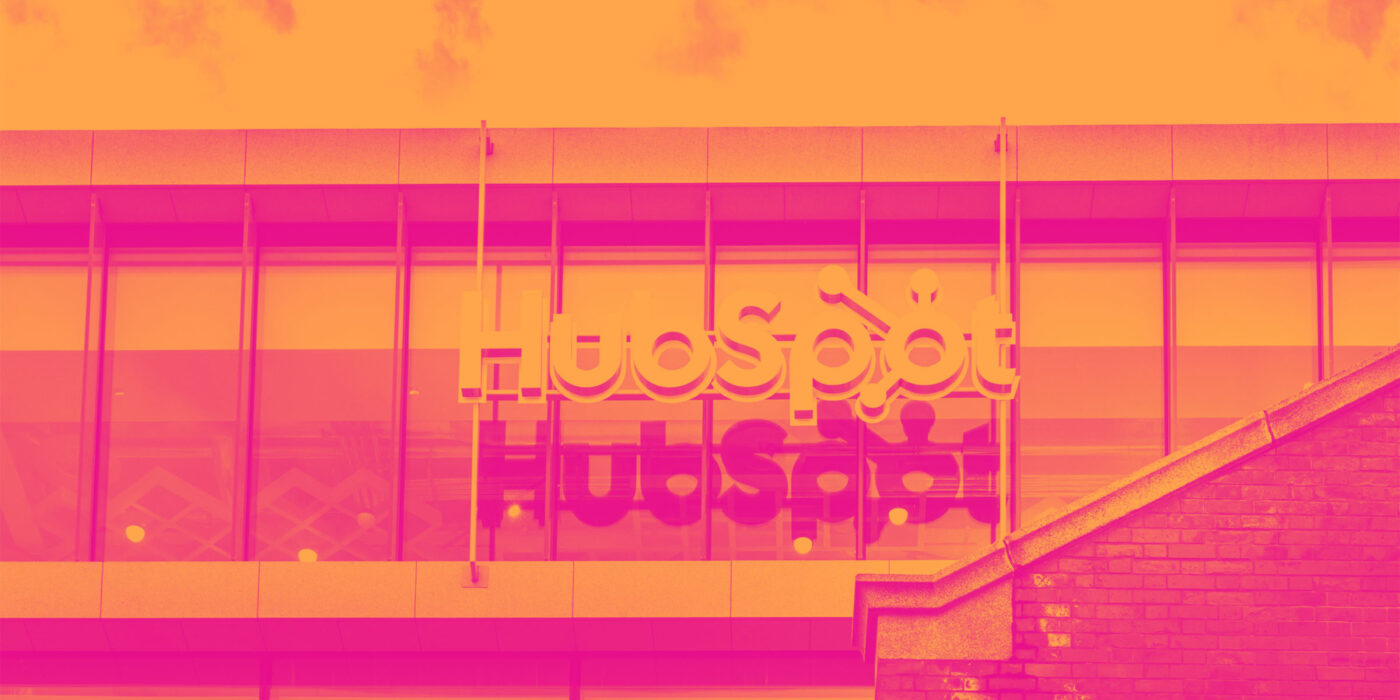Sales and marketing software maker HubSpot (NYSE:HUBS) reported results ahead of analysts' expectations in Q1 CY2024, with revenue up 23.1% year on year to $617.4 million. On the other hand, the company expects next quarter's revenue to be around $618 million, slightly below analysts' estimates. It made a non-GAAP profit of $1.68 per share, improving from its profit of $1.20 per share in the same quarter last year.
HubSpot (HUBS) Q1 CY2024 Highlights:
- Revenue: $617.4 million vs analyst estimates of $598.2 million (3.2% beat)
- EPS (non-GAAP): $1.68 vs analyst estimates of $1.50 (12.2% beat)
- Revenue Guidance for Q2 CY2024 is $618 million at the midpoint, below analyst estimates of $623.8 million
- The company reconfirmed its revenue guidance for the full year of $2.56 billion at the midpoint
- Gross Margin (GAAP): 84.6%, up from 83.6% in the same quarter last year
- Free Cash Flow of $99.57 million, up 26.8% from the previous quarter
- Customers: 216,840, up from 205,091 in the previous quarter
- Market Capitalization: $31.33 billion
Started in 2006 by two MIT grad students, HubSpot (NYSE:HUBS) is a software-as-a-service platform that helps small and medium-sized businesses market themselves, sell, and get found on the internet.
The platform integrates with a company’s website and database and provides easy-to-use tools to capture visitor’s information, automate email marketing, and create content marketing and sales campaigns. Companies using HubSpot are able to analyze their customers' behaviour and optimize the marketing based on who the customers are and what they need.
Hubspot pioneered the concept of inbound marketing, a strategy where companies attract customers by creating interesting content on topics their customers care about rather than buying ads. Practicing what they preach the company is attracting customers mainly by creating free online content and tools. That seems to be a fit for their business model because with the large number of smaller customers it would be too expensive to hire a classic enterprise sales team to sell to them.
For example, instead of cold calling potential customers or spending money on paid advertising, a typical mom-and-pop coffee shop could set up an online website and use tools provided by HubSpot to make their brand more visible on search sites such as Google. Google displays the coffee shop as part of the search results whenever people search for a good place to buy coffee, thereby providing more visibility which could eventually lead to sales.
Sales Software
Companies need to be able to interact with and sell to their customers as efficiently as possible. This reality coupled with the ongoing migration of enterprises to the cloud drives demand for cloud-based customer relationship management (CRM) software that integrates data analytics with sales and marketing functions.
Being the pioneer in the inbound marketing niche has helped HubSpot manage competition from companies such as Zoho and Salesforce (NYSE:CRM).
Sales Growth
As you can see below, HubSpot's revenue growth has been very strong over the last three years, growing from $281.4 million in Q1 2021 to $617.4 million this quarter.
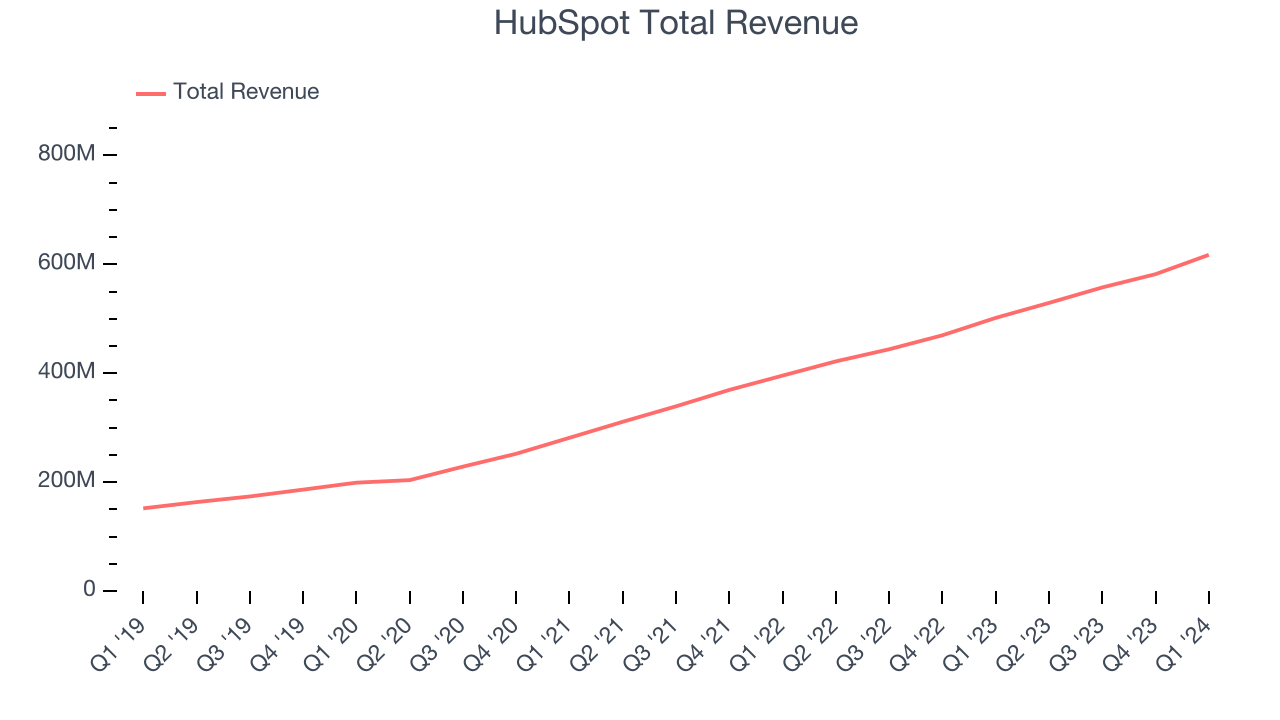
This quarter, HubSpot's quarterly revenue was once again up a very solid 23.1% year on year. On top of that, its revenue increased $35.5 million quarter on quarter, a very strong improvement from the $24.36 million increase in Q4 CY2023. This is a sign of acceleration of growth and great to see.
Next quarter's guidance suggests that HubSpot is expecting revenue to grow 16.8% year on year to $618 million, slowing down from the 25.5% year-on-year increase it recorded in the same quarter last year. Looking ahead, analysts covering the company were expecting sales to grow 17.1% over the next 12 months before the earnings results announcement.
Customer Growth
HubSpot reported 216,840 customers at the end of the quarter, an increase of 11,749 from the previous quarter. That's roughly the same customer growth as we observed last quarter and quite a bit above what we've typically seen over the last year, confirming that the company is sustaining a good sales pace.
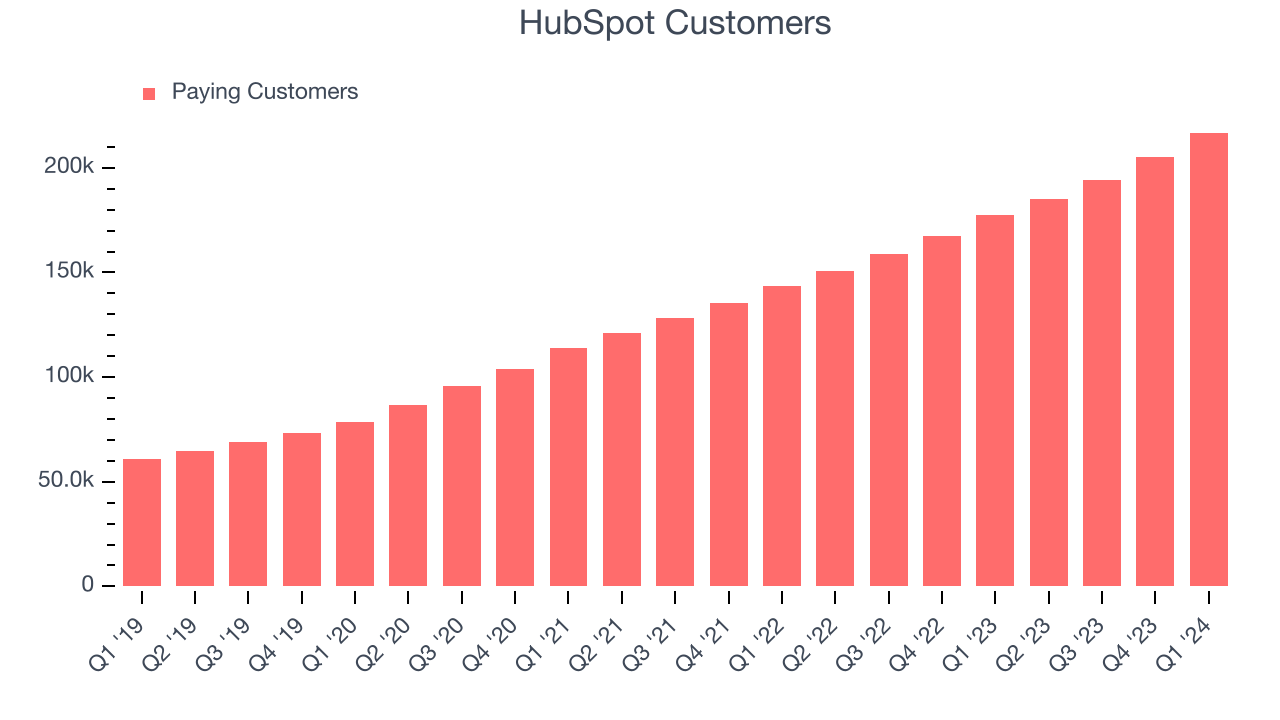
Profitability
What makes the software as a service business so attractive is that once the software is developed, it typically shouldn't cost much to provide it as an ongoing service to customers. HubSpot's gross profit margin, an important metric measuring how much money there's left after paying for servers, licenses, technical support, and other necessary running expenses, was 84.6% in Q1.
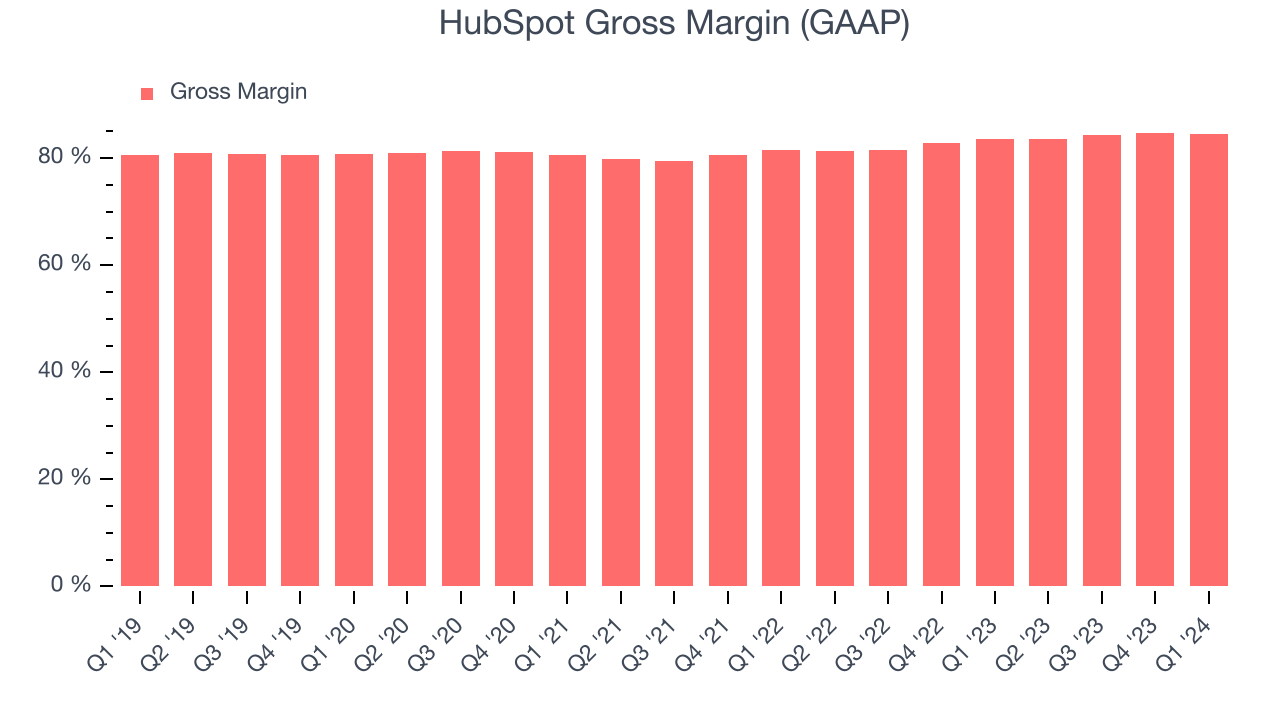
That means that for every $1 in revenue the company had $0.85 left to spend on developing new products, sales and marketing, and general administrative overhead. HubSpot's excellent gross margin allows it to fund large investments in product and sales during periods of rapid growth and achieve profitability when reaching maturity. It's also comforting to see its gross margin remain stable, indicating that HubSpot is controlling its costs and not under pressure from its competitors to lower prices.
Cash Is King
If you've followed StockStory for a while, you know that we emphasize free cash flow. Why, you ask? We believe that in the end, cash is king, and you can't use accounting profits to pay the bills. HubSpot's free cash flow came in at $99.57 million in Q1, up 59% year on year.
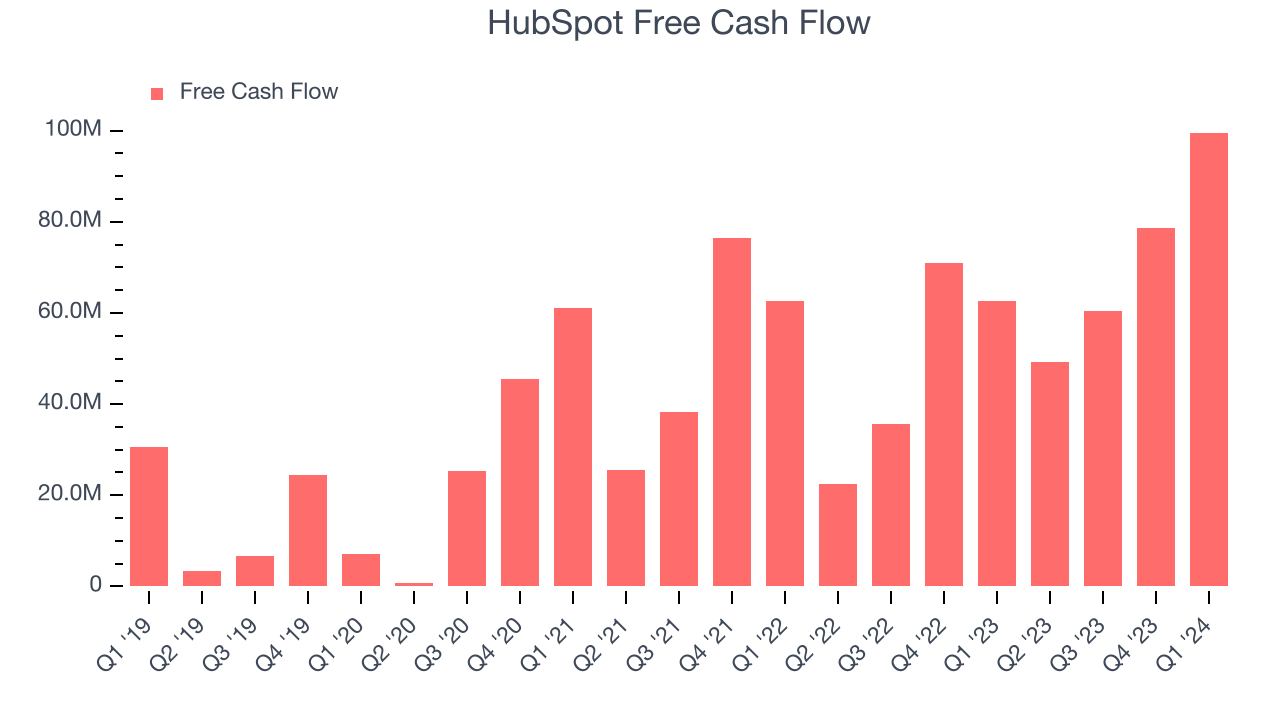
HubSpot has generated $287.8 million in free cash flow over the last 12 months, a decent 12.6% of revenue. This FCF margin stems from its asset-lite business model and gives it a decent amount of cash to reinvest in its business.
Key Takeaways from HubSpot's Q1 Results
We enjoyed seeing HubSpot exceed analysts' billings expectations this quarter. Free cash flow also came in strong, on top of a top-line beat. On the other hand, its quarterly revenue guidance slightly missed Wall Street's estimates but the company seems to believe it will make up for it later in the year as full year guidance was unchanged. Overall, this was a decent quarter for HubSpot. The stock is up 1.9% after reporting and currently trades at $601 per share.
Is Now The Time?
When considering an investment in HubSpot, investors should take into account its valuation and business qualities as well as what's happened in the latest quarter.
There are several reasons why we think HubSpot is a great business. While we'd expect growth rates to moderate from here, its revenue growth has been impressive over the last three years. Additionally, its impressive gross margins indicate excellent business economics, and its efficient customer acquisition is better than many similar companies.
HubSpot's price-to-sales ratio of 11.4x based on the next 12 months indicates the market is optimistic about its growth prospects. But looking at the tech landscape today, HubSpot's qualities stand out. We still like the stock at this price, despite the higher multiple.
Wall Street analysts covering the company had a one-year price target of $701.53 right before these results (compared to the current share price of $601).
To get the best start with StockStory, check out our most recent Stock picks, and then sign up for our earnings alerts by adding companies to your watchlist here. We typically have the quarterly earnings results analyzed within seconds of the data being released. Especially for companies reporting pre-market, this often gives investors the chance to react to the results before everyone else has fully absorbed the information.
